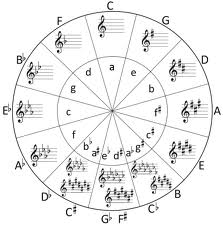Oh, my goodness…Have you ever looked at something and all you could think of was “huh”?! Yep, me too. That was exactly my reaction when I first looked at the circle of fifths. How could this crazy picture possibly make sense?
Well, it can make sense and this is just one of many tools musicians use for remembering scales and key signatures.
Understanding the Circle of Fifths
The main purpose of the circle of fifths is to show us the relationships between keys.
 Sharp Keys
Sharp Keys
If you start at the top of the circle of fifths and move clockwise (to the right), you will notice that a sharp is added each time.
I like to think of the circle of fifths as though it is an actual clock. The very top of the clock is C Major at zero o’clock. It is “0” because there are no flats or sharps in this key.
The very next key to the right is G major at one o’clock. This key has only 1 sharp (F#). G major also happens to be the 5th note of the C major scale.
In fact, if you keep moving clockwise, the next key is the fifth note of the previous key. In other words, the fifth note of one scale becomes the first note of the next scale as you move around the circle to the right.
Now do you see why they call this the circle of fifths?
List of Major Sharp Keys
0 o’clock = C Major (no sharps or flats)
1 o’clock = G Major (1 sharp = F#)
2 o’clock = D Major (2 sharps = F# & C#)
3 o’clock = A Major (3 sharps = F#, C# & G#)
4 o’clock = E Major (4 sharps = F#, C#, G# & D#)
5 o’clock = B Major (5 sharps = F#, C#, G#, D# & A#)
6 o’clock = F# Major (6 sharps = F#, C#, G#, D#, A# & E#)
7 o’clock = C# Major (7 sharps = F#, C#, G#, D#, A#, E# & B#)
As you go around the circle to the right, a sharp is continually added to the key signature. The sharps that are added follow the order of sharps (F – C – G – D – A – E – B).
Flat Keys
The flat keys start at the top with C major and move counter-clockwise (to the left). As you go around the circle, a flat is added to each key with movement happening by fourths.
For example, “F” is the 4th note of the C major scale. “Bb” is the 4th note of the F major scale. This continues all the way around to the key of Cb.
Another interesting detail is that if you start with the last flat key (Cb) and move backwards (to the left), the next key (Gb) is the 5th note of the previous key. This continues all the way around to the top key, C major.
We can follow the flat keys around to the left like a clock just as we did with the sharps keys. C major is zero o’clock with no sharps or flats. F major is one o’clock with 1 flat, Bb. This keeps moving around adding a flat each time to the key signature.
List of Major Flat Keys
0 o’clock = C Major (no flats or sharps)
1 o’clock = F Major (1 flat = Bb)
2 o’clock = Bb Major (2 flats = Bb & Eb)
3 o’clock = Eb Major (3 flats = Bb, Eb & Ab)
4 o’clock = Ab Major (4 flats = Bb, Eb, Ab & Db)
5 o’clock = Db Major (5 flats = Bb, Eb, Ab, Db & Gb)
6 o’clock = Gb Major (6 flats = Bb, Eb, Ab, Db, Gb & Cb)
7 o’clock = Cb Major (7 flats = Bb, Eb, Ab, Db, Gb, Cb & Fb)
When you start at the top of the clock and move around to the left, each flat added to the key signature follows the order of flats (B – E – A – D – G – C – F).
Minor Keys
The small letters inside of the wheel represent the relative minor keys of each of the major keys. The major and minor keys are related by their shared key signatures. The minor keys will work in the same exact way as the major keys when you work your way around the circle of fifths.
Things to Remember
1) The sharp keys start at the top and add 1 sharp each time as you move around the circle to the right. The sharps that are added follow the order of sharps. The keys themselves move by fifths.
2) The flat keys start at the top and move around to the left adding 1 flat to the key signature each time. The flat that is added to the key signature follows the order of flats. The flat keys move by fourths, but if you go backwards (starting with the last flat key and moving up to the left), they move by fifths.
Understanding the circle of fifths does not have to be a painful experience. This is just one of those things where it actually looks more complicated than it really is. Take some time to really look it over and think about it. Who knows, you may find this to be one of your favorite tools to use!

Thanks for your helpful and thoughtful information Teresa. If you get a chance, could you post about the enharmonic keys and why they exist. I understand the major scale naming convention requires each letter A-G to be in the spelling of a given scale – giving rise to B#, Cb, E# and Fb spellings within their appropriate scale positions; but I haven’t yet clicked why we have the three enharmonic Keys Db, Gb and Cb.
Hi Tom, there really isn’t an easy way to answer why we have enharmonics. I will have to write an updated article about enharmonics soon and give some theories about this. In the mean time, read through this article on Enharmonics I wrote awhile ago and see if it helps.